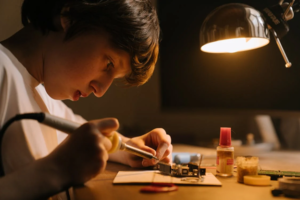Common Defects in PCB and How to Avoid Them
Printed circuit boards (PCBs) are essential components of many electrical devices today, connecting different components to one another through a complex network of circuits. Global demand for PCBs has risen rapidly —the global PCB sales were $78.367 billion in 2023.
As so much money is invested in PCBs, PCB failure is a major concern of many companies. This article will focus on the most common errors during PCB assembly and practical ways to avoid them.
What is PCB Failure?
PCB failure can occur for several reasons, and the device no longer operates as expected. PCBs are used in many electronics, including wearables, aircraft, satellites, and medical equipment.
That’s why failures should be identified and fixed quickly. If a company wants to ensure its electronics function properly, it must understand the causes of PCB failure.
REASONS FOR PCB FAILURE
PCB design and manufacturing are very complex, which is why there are chances of PCB failure or defects. Some of these failures result from mistakes made in the design, such as incorrect spacing or miscalculated measurements. Others may result from problems in the manufacturing process, such as drilling errors.
When it comes to PCB assembly, maintaining high quality is the basis. Even a small defect can affect the functionality of the circuit board. With consideration, most of these defects can be avoided.
For high-quality boards free from common defects, visit NextPCB. NextPCB helps prevent issues like short circuits, soldering defects, and bubbling
Source: Pexel
By being aware of the problems and knowing how to prevent them, you can save time, reduce costs, and ensure your PCBs perform as expected. To better understand and avoid these errors in your printed circuit board designs, here are some most common issues, why they occur, and how they can be prevented:
1- PCB Short Circuit Problem:
PCB Short circuit is one of the most common defects, typically confused with open circuit. An open circuit refers to the disconnection of the connected line due to a break in the middle of the line. A short circuit is when excess copper or other impurities appear between lines that should have a distance, resulting in line transmission failure.
- Scratches can cause a short circuit. Improper removal of the plate during electroplating, improper operation when placing the splint, etc., can result in scratches. The operator should control the spacing between the boards to avoid this situation.
- Electroplating problems can occur when the anti-coating layer is too thin, causing the coating to exceed the film thickness and form a sandwich. To solve this, Increase the thickness of the plating resist. If using a wet film, apply multiple printings.
2- PCB Soldering Defect Problem:
Companies without strict specifications can easily overlook Soldering defects as they are easy-to-avoid circuit board problems.
The most common concentrated welding problems are:
- Poor welding: Before the solder joints solidify, they are easily affected by external factors and cause the solder joints to move.
- Cold welding: Due to insufficient solder fusion, the surface is rough, and the connection is not firm. When this problem occurs, it is necessary to reheat the joint to remove excess solder.
3- Bubbling:
Cleaning circuit boards is an important part of the PCB manufacturing process. After the PCB is produced, its surface has many stains, such as oxidation, oil stains, and glue marks. These alkaline impurities rust the circuit board’s surface, breaking it down.
This board defect is caused by Insufficient curing time, Dirty Tin stripping, and water vapor in the hole.
Common PCB design issues
Common problems occur on printed circuit boards (PCBs) and often during design. To ensure the manufactured circuit board is error-free, designers must strictly check Copper spacing issues, six layers of connections, and a foolproof design solution.
Common PCB Assembly Problems
Common PCB assembly problems occur when Components are loose or misaligned, flux is not cleaned, or temperature is not favorable. The temperature is kept in the range of 24±2℃, and the humidity is kept in the range of 60±10%.
If you’re looking to resolve common PCB issues, explore PCB assembly services for reliable solutions
Conclusion:
In conclusion, PCB failure can disrupt the functionality of electronic devices, so it’s important to recognize and avoid frequent flaws. You can ensure your projects have effective PCBs by maintaining high-quality assembly procedures and utilizing services like NextPCB. Don’t let typical problems prevent you from using electronics; check out reliable options today!



